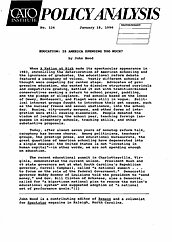Today, after almost seven years of nonstop reform talk, cacophony has become chorus. Among politicians, teachers’ groups, the prestige press, and educational bureaucrats, the great questions of American schooling have degenerated into a single message: the United States is not “investing in human capital”–in other words, we are not spending enough on education.
The recent educational summit in Charlottesville, Virginia, demonstrated the current unison. President Bush and 49 state governors met at what South Carolina’s Republican governor, Carroll Campbell, called “a national summit … to focus on the role of the Federal Government.” Democratic governor Buddy Roemer of Louisiana told the president to “send money,” and Gov. Bill Clinton of Arkansas, also a Democrat, called for “a bipartisan national plan to rescue the nation’s educational system” and suggested adoption of “a national set of performance goals.”(1)
The media now banter about financing with exuberant ease. President Bush, who wants to be known as the Education President, won’t put his money where his mouth is, network anchors confide with knowing smiles. In the realm of international business competition, write crusty Washington Post business reporters, America doesn’t have the will to make tough investment choices. And compassionate commentators remark on the poor rural school district that spends only half as much per pupil as does the nearby city district–as if that means rural students receive half the education their urban peers do.
For most Washington politicians and the national media, how education should be structured and directed has become simply a question of dollars and cents; they assume that each increment of funding creates an increment of learning. Their fixation is completely divorced from reality. In the past three decades, spending on education has risen steadily to a level unsurpassed in U.S. history and, indeed, to one of the highest in the world. Meanwhile, academic researchers have conducted study after study, trying to find evidence for the spending‐equals‐learning theory. They haven’t. And all the while, experiments in the trenches–from inner‐city schools in Harlem to suburban schools in Minnesota–have been demonstrating that local control and parental choice, structural changes that are money neutral, hold the key to real educational reform.
Somehow such major news events have escaped the notice of the reform chorus, whose members continue, undaunted, to peddle their flawed vision of our educational woes. Theirs is a bill of goods that Americans, frustrated with inferior schools, will certainly buy–unless they get better consumer information.

